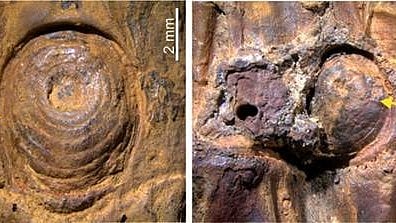
Fossils of thorny bamboo found in Manipur.
Credit: Press Information Bureau.
Guwahati: In what may further enrich Asia's botanical history, researchers have stumbled on fossils of 37,000-year-old thorny bamboo stem dating back to the Ice Age from a silt-rich deposits of a river in Manipur.
This, according to the research team, is the first such record of thorny bamboo fossils in the Asia and could fill the gap in global fossil record of thorny bamboos.
"The discovery is remarkable for capturing fragile details like thorn scars—features that almost never fossilize. The finding also highlights the Indo-Burma biodiversity hotspot as a crucial refugium during the Ice Age. While colder and drier climates eliminated bamboo from places such as Europe, the warm and humid conditions of Northeast India allowed it to persist," said a paper published by the team from the Lucknow-based Birbal Sahni Institution of Palaeosciences, an institution under the Centre's Department of Science and Technology (DST).
The stem of the bamboo with marks of long-vanished thorns were found inside deposits of the Chirang river at Senjam-Chirang village in Imphal West district, situated about 20 km west of Manipur capital Imphal.
"Bamboo fossils are extremely rare because their hollow stems and fibrous tissues decay rapidly, leaving little trace in the geological record. Scientists usually understood bamboo defences mainly by comparing modern species with their habitats."
The development of spines, prickles, and thorns—collectively known as spinescence—is an adaptive trait that serves as a physical defense mechanism against vertebrate herbivores.
The findings were published in the Journal Review of Palaeobotany and Palynology, recently. H Bhatia, P Kumari, NH Singh and G Srivastava are part of the research team.
Within the Poaceae family, bamboos plays a critical ecological and socio-economic role, thriving primarily in tropical and subtropical regions. Major bamboo populations are found in East and Southeast Asia, as well as on the islands of the Indian and Pacific Oceans.
However, the evolutionary history of these structures in bamboos is poorly understood due to a lack of fossil evidence. Globally, only one thorny bamboo fossil, identified as Guadua sp., has been reported from Pliocene–Pleistocene sediments in Peru, South America, the paper said.
"This fossil adds a new dimension to our understanding of both bamboo evolution and regional climate history. It also emphasizes the role of this part of Asia in safeguarding biodiversity during times of global stress, making the discovery not only a botanical milestone but also an important contribution to palaeoclimatic and biogeographic studies," it said.